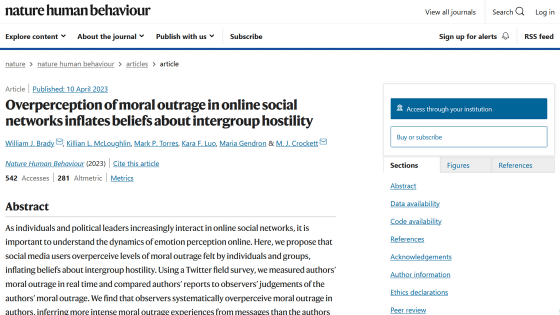People tend to read ``anger'' excessively on Twitter, the tweeter may not be as angry as the reader thinks

It is known that
Overperception of moral outrage in online social networks inflates beliefs about intergroup hostility | Nature Human Behavior
https://doi.org/10.1038/s41562-023-01582-0

Are People on Social Media Actually That Outraged?
https://insight.kellogg.northwestern.edu/article/social-media-twitter-outrage
Brady's research team used machine learning to analyze tweets posted on Twitter in real time to investigate the difference between the anger felt by readers on SNS and the anger actually felt by the poster. He then identified a tweet that mentioned American politics, contacted the poster via direct message within 15 minutes of posting, and asked how angry or happy he felt when he wrote the tweet.
Next, we asked about 650 subjects to see the tweets that knew the degree of anger of the poster and evaluated 'how angry or happy the person who posted it was.' Subjects also reported how often they used social media to learn about American politics.
When we analyzed these data, we found that subjects who saw the tweets tended to rate the anger they felt from the tweets higher than what the posters actually reported. Interestingly, the poster's happiness did not tend to be overestimated, and negative emotions were more likely to be overestimated. We also found that the tendency to overestimate anger was strongest among subjects who often learned about politics through social media.
'This correlation can be explained by shaping expectations about how people express themselves and how they feel when they spend more time on social media,' Brady said. Forming expectations will influence your judgment the next time you see what you see as an outrage.' In other words, people who often use social media form expectations that ``people will surely be angry about this topic,'' and overestimate the anger of posters when they see posts related to it.

In addition, the research team used the tweets used in the first experiment to reproduce two types of feeds to examine not only individual posts and feeds but also anger perceptions of the 'whole platform'. The two feeds were comparable in the degree of anger reported by the posters, but one feed was the 'high overperceived feed' where subjects felt more anger and the other feed felt less anger. It was a 'low overrecognition feed'.
600 newly recruited subjects were then randomly shown these feeds and asked to rate on a scale of 1 to 7 how angry members of the feed and the platform as a whole were.
As a result of the experiment, subjects who were shown the high overrecognition feed rated the overall anger of the platform as '5.82' on average, and subjects who were shown the low overrecognition feed rated it as '3.53' on average. Subjects who viewed high overperception feeds relied heavily on ``the most angry-looking tweets'' in assessing anger across the platform, with inflammatory tweets in particular affecting perceptions across the platform. was suggested.

In another experiment with 1200 new subjects, after showing the subjects one of the two feeds used in the previous experiment, five ``tweets that the poster had strong anger'' He showed five ``tweets where the poster was emotionally neutral''. Subjects rated how socially appropriate these 10 tweets were on the platform they viewed earlier, and how polarized the platform was.
Subjects who viewed the high overperception feed judged that tweets expressing high levels of anger were 'more appropriate than neutral tweets', and said the platform was more likely to be politically polarized. tended to.
``People see social networks as more biased than they really are. It has been suggested that people may be more likely to follow the 'norms of expressing anger' when they are overrepresented by algorithms,' he said.
Readers tend to perceive more anger from tweets, even if the tweeters weren't actually that angry. As a result, they may perceive that ``it is more appropriate to express anger in this place,'' and may express anger themselves in accordance with that norm.
Addressing anger hype on social media may require changes in platform design and presentation priorities. Brady also believes it's important for ordinary users to understand how social media works, and to understand prejudices and misconceptions. Brady pointed out that the content you see on your feed isn't necessarily representative of your social network, and people behind your screen may not be as angry as you think they are.

Related Posts:
in Web Service, Science, Posted by log1h_ik






